Movie Exhibition Industry: Competitive Strategy and Revenue Analysis
VerifiedAdded on 2022/11/22
|11
|2828
|110
Report
AI Summary
This report provides a comprehensive analysis of the movie exhibition industry, focusing on the challenges and strategies employed by major players to increase revenue. The report examines the competitive landscape, including the dynamics between cinema theaters and studios, and how technological advancements impact costs and viewer experiences. It delves into various strategic approaches, such as business, corporate, international, cooperative, and sustainability strategies, to address declining profits and evolving market trends. The analysis includes a comparison of four major exhibitor circuits, their competitive advantages and disadvantages, and the strategic issues they face, such as declining profits, changing consumer behavior, technological advancements, and global forces. The report also covers relevant theoretical concepts, including business strategy, competitive dynamics, corporate strategy, acquisitions, international strategy, cooperative strategy, and sustainability, to provide a holistic view of the industry's challenges and opportunities.
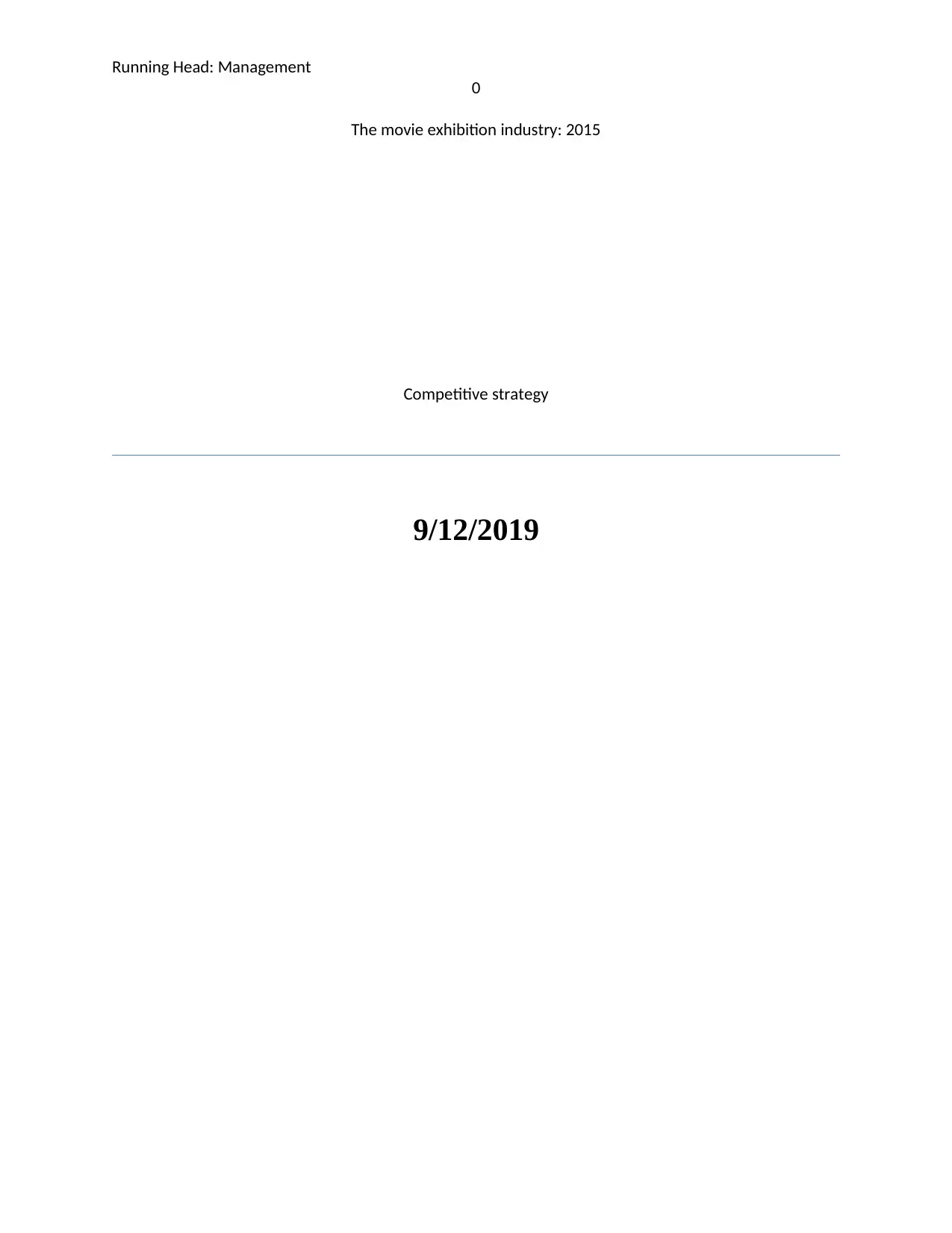
Running Head: Management
0
The movie exhibition industry: 2015
Competitive strategy
9/12/2019
0
The movie exhibition industry: 2015
Competitive strategy
9/12/2019
Paraphrase This Document
Need a fresh take? Get an instant paraphrase of this document with our AI Paraphraser
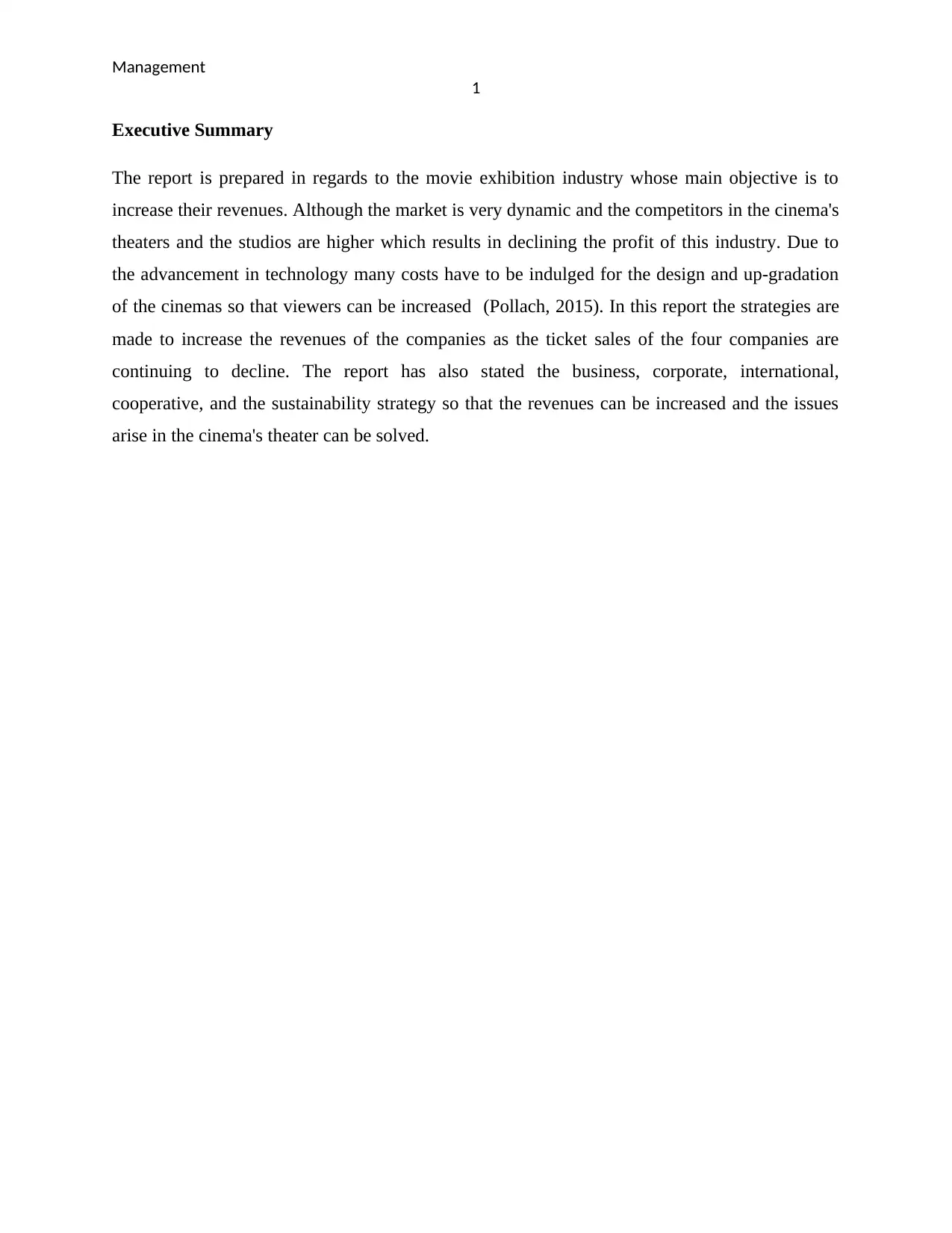
Management
1
Executive Summary
The report is prepared in regards to the movie exhibition industry whose main objective is to
increase their revenues. Although the market is very dynamic and the competitors in the cinema's
theaters and the studios are higher which results in declining the profit of this industry. Due to
the advancement in technology many costs have to be indulged for the design and up-gradation
of the cinemas so that viewers can be increased (Pollach, 2015). In this report the strategies are
made to increase the revenues of the companies as the ticket sales of the four companies are
continuing to decline. The report has also stated the business, corporate, international,
cooperative, and the sustainability strategy so that the revenues can be increased and the issues
arise in the cinema's theater can be solved.
1
Executive Summary
The report is prepared in regards to the movie exhibition industry whose main objective is to
increase their revenues. Although the market is very dynamic and the competitors in the cinema's
theaters and the studios are higher which results in declining the profit of this industry. Due to
the advancement in technology many costs have to be indulged for the design and up-gradation
of the cinemas so that viewers can be increased (Pollach, 2015). In this report the strategies are
made to increase the revenues of the companies as the ticket sales of the four companies are
continuing to decline. The report has also stated the business, corporate, international,
cooperative, and the sustainability strategy so that the revenues can be increased and the issues
arise in the cinema's theater can be solved.
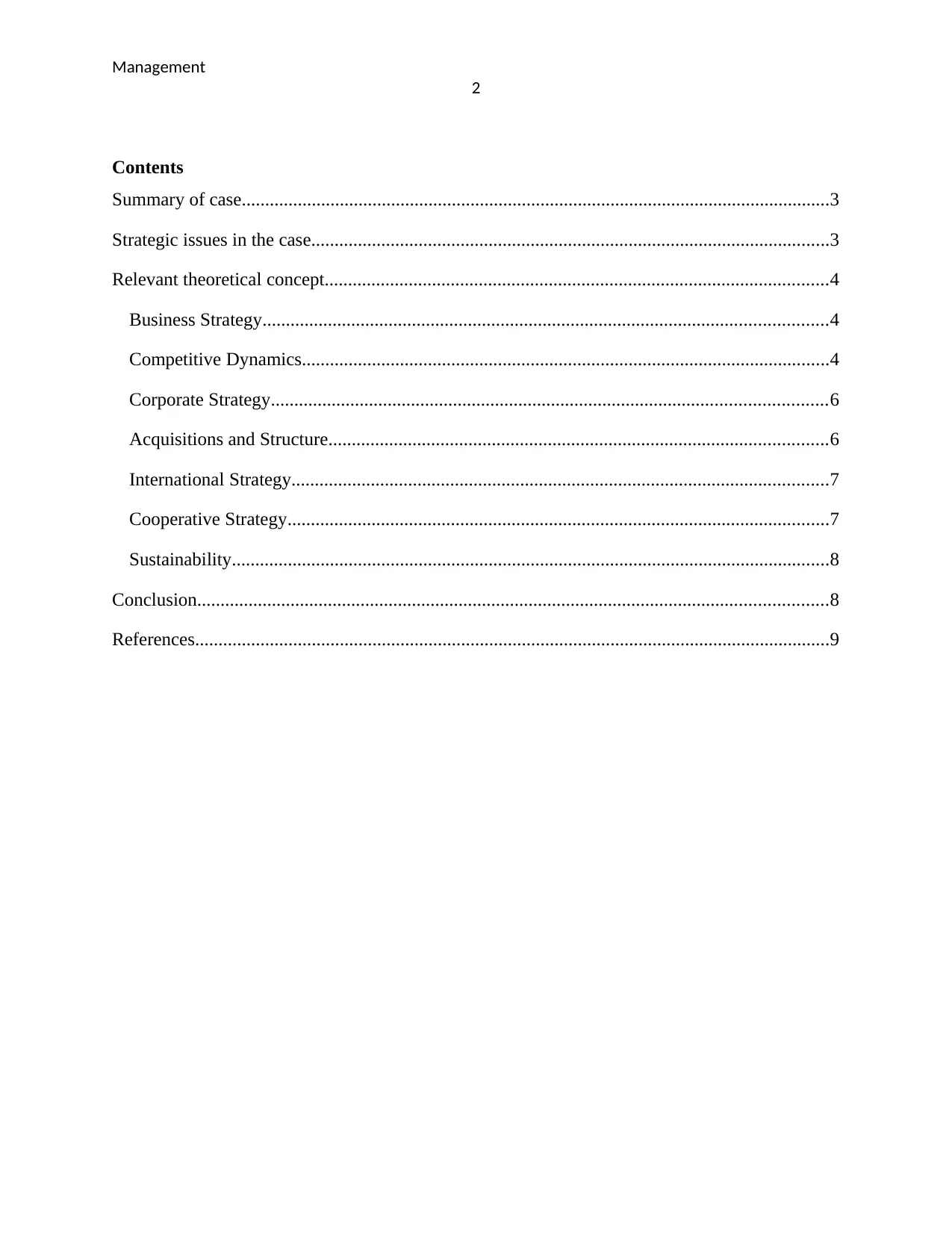
Management
2
Contents
Summary of case..............................................................................................................................3
Strategic issues in the case...............................................................................................................3
Relevant theoretical concept............................................................................................................4
Business Strategy.........................................................................................................................4
Competitive Dynamics.................................................................................................................4
Corporate Strategy.......................................................................................................................6
Acquisitions and Structure...........................................................................................................6
International Strategy...................................................................................................................7
Cooperative Strategy....................................................................................................................7
Sustainability................................................................................................................................8
Conclusion.......................................................................................................................................8
References........................................................................................................................................9
2
Contents
Summary of case..............................................................................................................................3
Strategic issues in the case...............................................................................................................3
Relevant theoretical concept............................................................................................................4
Business Strategy.........................................................................................................................4
Competitive Dynamics.................................................................................................................4
Corporate Strategy.......................................................................................................................6
Acquisitions and Structure...........................................................................................................6
International Strategy...................................................................................................................7
Cooperative Strategy....................................................................................................................7
Sustainability................................................................................................................................8
Conclusion.......................................................................................................................................8
References........................................................................................................................................9
⊘ This is a preview!⊘
Do you want full access?
Subscribe today to unlock all pages.

Trusted by 1+ million students worldwide
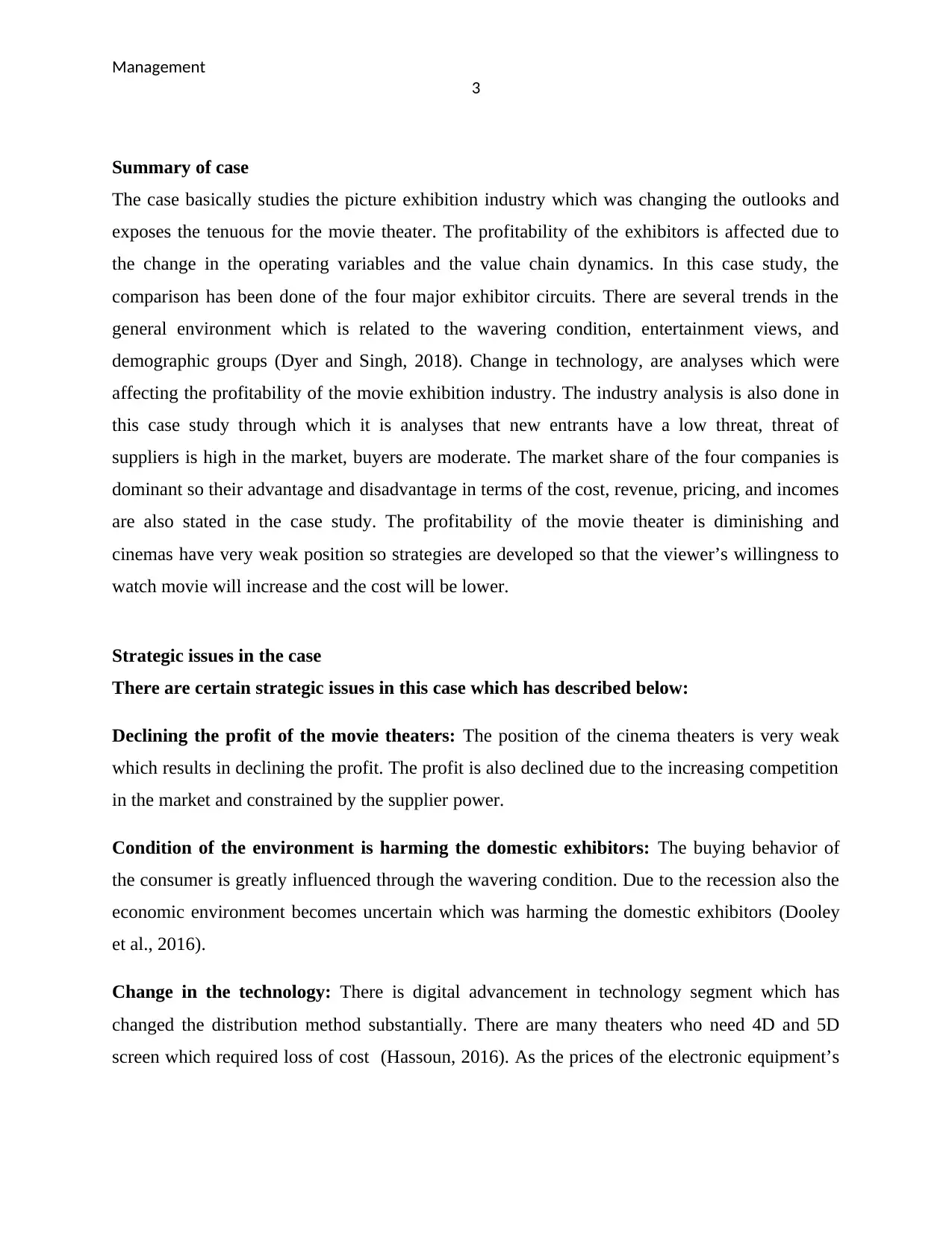
Management
3
Summary of case
The case basically studies the picture exhibition industry which was changing the outlooks and
exposes the tenuous for the movie theater. The profitability of the exhibitors is affected due to
the change in the operating variables and the value chain dynamics. In this case study, the
comparison has been done of the four major exhibitor circuits. There are several trends in the
general environment which is related to the wavering condition, entertainment views, and
demographic groups (Dyer and Singh, 2018). Change in technology, are analyses which were
affecting the profitability of the movie exhibition industry. The industry analysis is also done in
this case study through which it is analyses that new entrants have a low threat, threat of
suppliers is high in the market, buyers are moderate. The market share of the four companies is
dominant so their advantage and disadvantage in terms of the cost, revenue, pricing, and incomes
are also stated in the case study. The profitability of the movie theater is diminishing and
cinemas have very weak position so strategies are developed so that the viewer’s willingness to
watch movie will increase and the cost will be lower.
Strategic issues in the case
There are certain strategic issues in this case which has described below:
Declining the profit of the movie theaters: The position of the cinema theaters is very weak
which results in declining the profit. The profit is also declined due to the increasing competition
in the market and constrained by the supplier power.
Condition of the environment is harming the domestic exhibitors: The buying behavior of
the consumer is greatly influenced through the wavering condition. Due to the recession also the
economic environment becomes uncertain which was harming the domestic exhibitors (Dooley
et al., 2016).
Change in the technology: There is digital advancement in technology segment which has
changed the distribution method substantially. There are many theaters who need 4D and 5D
screen which required loss of cost (Hassoun, 2016). As the prices of the electronic equipment’s
3
Summary of case
The case basically studies the picture exhibition industry which was changing the outlooks and
exposes the tenuous for the movie theater. The profitability of the exhibitors is affected due to
the change in the operating variables and the value chain dynamics. In this case study, the
comparison has been done of the four major exhibitor circuits. There are several trends in the
general environment which is related to the wavering condition, entertainment views, and
demographic groups (Dyer and Singh, 2018). Change in technology, are analyses which were
affecting the profitability of the movie exhibition industry. The industry analysis is also done in
this case study through which it is analyses that new entrants have a low threat, threat of
suppliers is high in the market, buyers are moderate. The market share of the four companies is
dominant so their advantage and disadvantage in terms of the cost, revenue, pricing, and incomes
are also stated in the case study. The profitability of the movie theater is diminishing and
cinemas have very weak position so strategies are developed so that the viewer’s willingness to
watch movie will increase and the cost will be lower.
Strategic issues in the case
There are certain strategic issues in this case which has described below:
Declining the profit of the movie theaters: The position of the cinema theaters is very weak
which results in declining the profit. The profit is also declined due to the increasing competition
in the market and constrained by the supplier power.
Condition of the environment is harming the domestic exhibitors: The buying behavior of
the consumer is greatly influenced through the wavering condition. Due to the recession also the
economic environment becomes uncertain which was harming the domestic exhibitors (Dooley
et al., 2016).
Change in the technology: There is digital advancement in technology segment which has
changed the distribution method substantially. There are many theaters who need 4D and 5D
screen which required loss of cost (Hassoun, 2016). As the prices of the electronic equipment’s
Paraphrase This Document
Need a fresh take? Get an instant paraphrase of this document with our AI Paraphraser
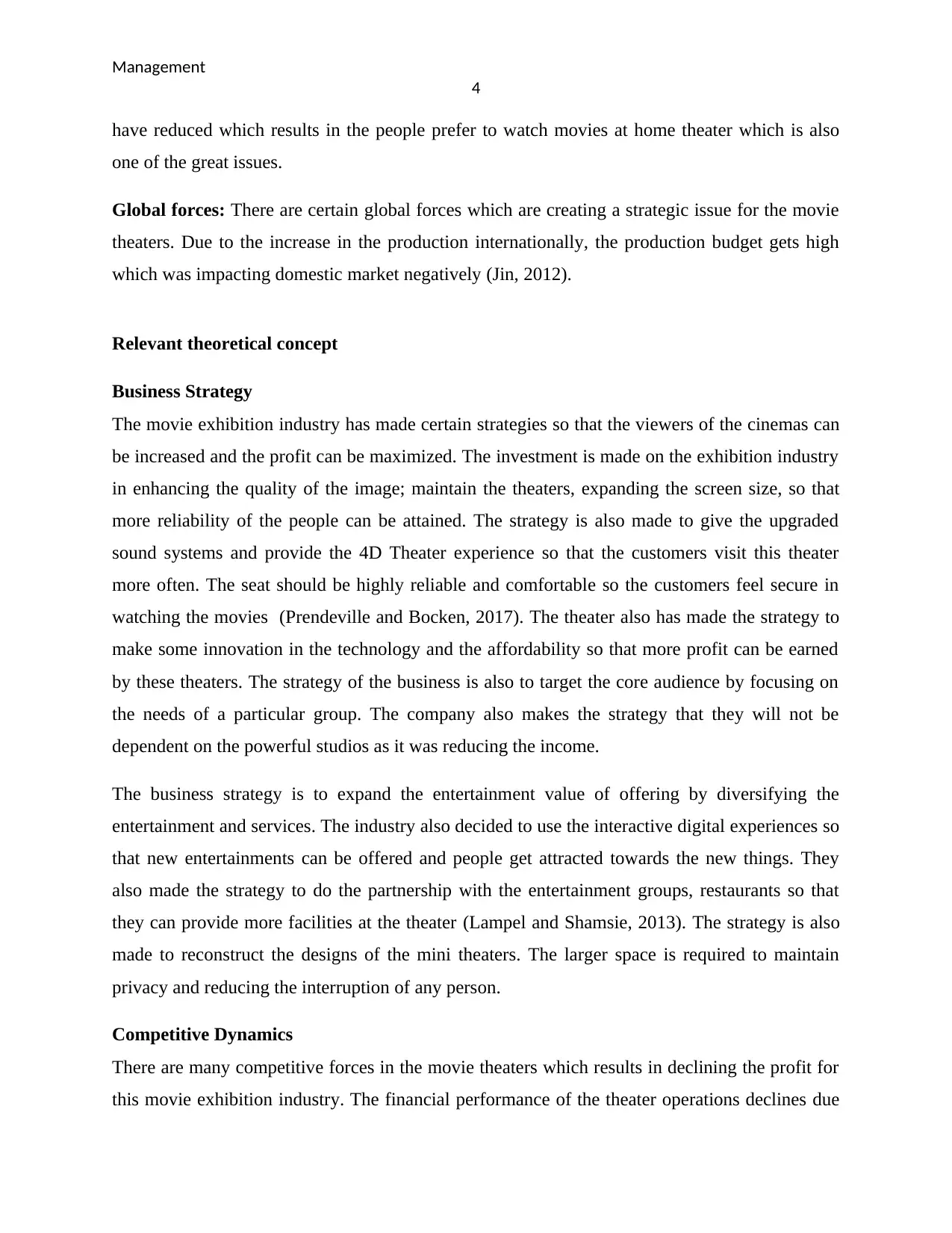
Management
4
have reduced which results in the people prefer to watch movies at home theater which is also
one of the great issues.
Global forces: There are certain global forces which are creating a strategic issue for the movie
theaters. Due to the increase in the production internationally, the production budget gets high
which was impacting domestic market negatively (Jin, 2012).
Relevant theoretical concept
Business Strategy
The movie exhibition industry has made certain strategies so that the viewers of the cinemas can
be increased and the profit can be maximized. The investment is made on the exhibition industry
in enhancing the quality of the image; maintain the theaters, expanding the screen size, so that
more reliability of the people can be attained. The strategy is also made to give the upgraded
sound systems and provide the 4D Theater experience so that the customers visit this theater
more often. The seat should be highly reliable and comfortable so the customers feel secure in
watching the movies (Prendeville and Bocken, 2017). The theater also has made the strategy to
make some innovation in the technology and the affordability so that more profit can be earned
by these theaters. The strategy of the business is also to target the core audience by focusing on
the needs of a particular group. The company also makes the strategy that they will not be
dependent on the powerful studios as it was reducing the income.
The business strategy is to expand the entertainment value of offering by diversifying the
entertainment and services. The industry also decided to use the interactive digital experiences so
that new entertainments can be offered and people get attracted towards the new things. They
also made the strategy to do the partnership with the entertainment groups, restaurants so that
they can provide more facilities at the theater (Lampel and Shamsie, 2013). The strategy is also
made to reconstruct the designs of the mini theaters. The larger space is required to maintain
privacy and reducing the interruption of any person.
Competitive Dynamics
There are many competitive forces in the movie theaters which results in declining the profit for
this movie exhibition industry. The financial performance of the theater operations declines due
4
have reduced which results in the people prefer to watch movies at home theater which is also
one of the great issues.
Global forces: There are certain global forces which are creating a strategic issue for the movie
theaters. Due to the increase in the production internationally, the production budget gets high
which was impacting domestic market negatively (Jin, 2012).
Relevant theoretical concept
Business Strategy
The movie exhibition industry has made certain strategies so that the viewers of the cinemas can
be increased and the profit can be maximized. The investment is made on the exhibition industry
in enhancing the quality of the image; maintain the theaters, expanding the screen size, so that
more reliability of the people can be attained. The strategy is also made to give the upgraded
sound systems and provide the 4D Theater experience so that the customers visit this theater
more often. The seat should be highly reliable and comfortable so the customers feel secure in
watching the movies (Prendeville and Bocken, 2017). The theater also has made the strategy to
make some innovation in the technology and the affordability so that more profit can be earned
by these theaters. The strategy of the business is also to target the core audience by focusing on
the needs of a particular group. The company also makes the strategy that they will not be
dependent on the powerful studios as it was reducing the income.
The business strategy is to expand the entertainment value of offering by diversifying the
entertainment and services. The industry also decided to use the interactive digital experiences so
that new entertainments can be offered and people get attracted towards the new things. They
also made the strategy to do the partnership with the entertainment groups, restaurants so that
they can provide more facilities at the theater (Lampel and Shamsie, 2013). The strategy is also
made to reconstruct the designs of the mini theaters. The larger space is required to maintain
privacy and reducing the interruption of any person.
Competitive Dynamics
There are many competitive forces in the movie theaters which results in declining the profit for
this movie exhibition industry. The financial performance of the theater operations declines due
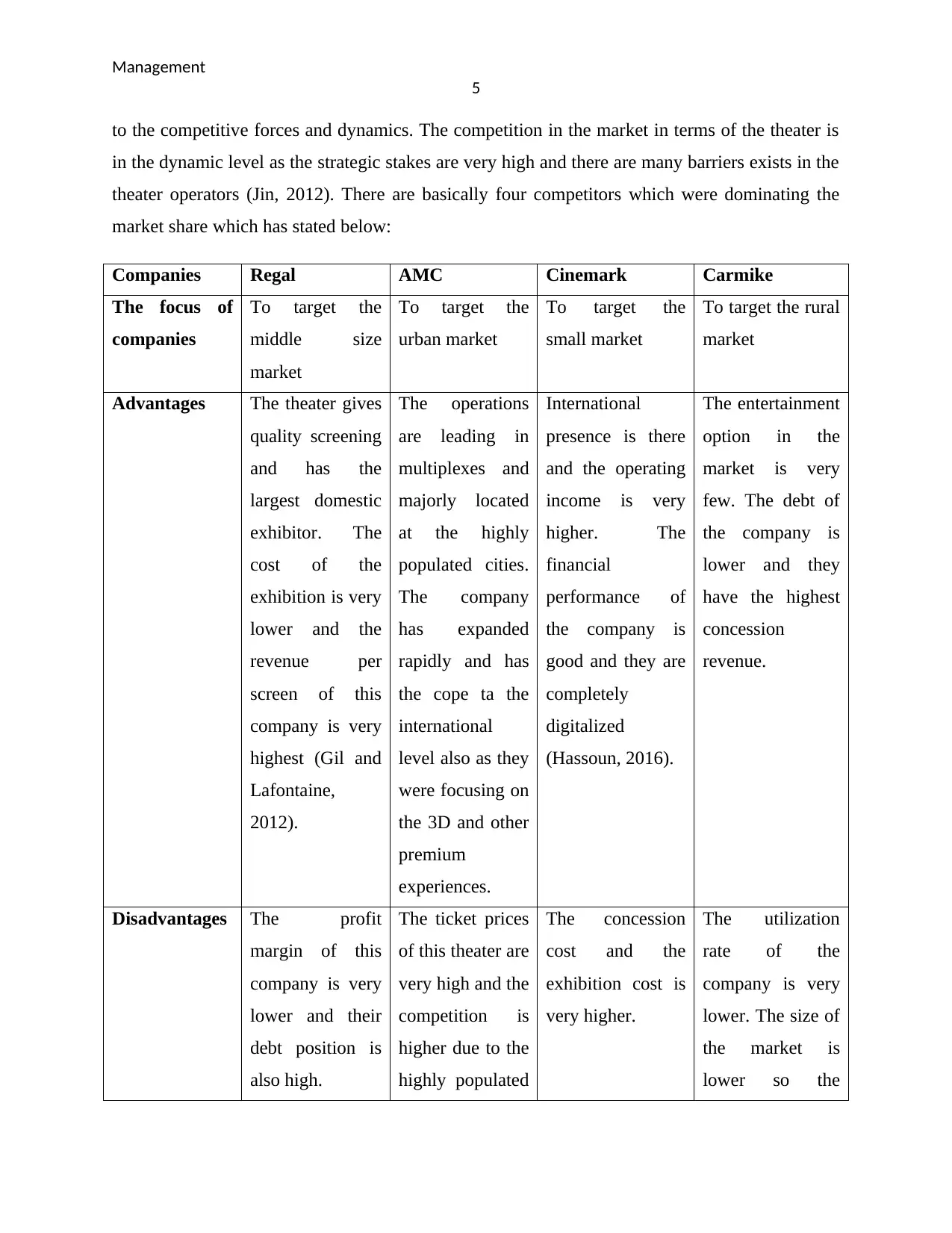
Management
5
to the competitive forces and dynamics. The competition in the market in terms of the theater is
in the dynamic level as the strategic stakes are very high and there are many barriers exists in the
theater operators (Jin, 2012). There are basically four competitors which were dominating the
market share which has stated below:
Companies Regal AMC Cinemark Carmike
The focus of
companies
To target the
middle size
market
To target the
urban market
To target the
small market
To target the rural
market
Advantages The theater gives
quality screening
and has the
largest domestic
exhibitor. The
cost of the
exhibition is very
lower and the
revenue per
screen of this
company is very
highest (Gil and
Lafontaine,
2012).
The operations
are leading in
multiplexes and
majorly located
at the highly
populated cities.
The company
has expanded
rapidly and has
the cope ta the
international
level also as they
were focusing on
the 3D and other
premium
experiences.
International
presence is there
and the operating
income is very
higher. The
financial
performance of
the company is
good and they are
completely
digitalized
(Hassoun, 2016).
The entertainment
option in the
market is very
few. The debt of
the company is
lower and they
have the highest
concession
revenue.
Disadvantages The profit
margin of this
company is very
lower and their
debt position is
also high.
The ticket prices
of this theater are
very high and the
competition is
higher due to the
highly populated
The concession
cost and the
exhibition cost is
very higher.
The utilization
rate of the
company is very
lower. The size of
the market is
lower so the
5
to the competitive forces and dynamics. The competition in the market in terms of the theater is
in the dynamic level as the strategic stakes are very high and there are many barriers exists in the
theater operators (Jin, 2012). There are basically four competitors which were dominating the
market share which has stated below:
Companies Regal AMC Cinemark Carmike
The focus of
companies
To target the
middle size
market
To target the
urban market
To target the
small market
To target the rural
market
Advantages The theater gives
quality screening
and has the
largest domestic
exhibitor. The
cost of the
exhibition is very
lower and the
revenue per
screen of this
company is very
highest (Gil and
Lafontaine,
2012).
The operations
are leading in
multiplexes and
majorly located
at the highly
populated cities.
The company
has expanded
rapidly and has
the cope ta the
international
level also as they
were focusing on
the 3D and other
premium
experiences.
International
presence is there
and the operating
income is very
higher. The
financial
performance of
the company is
good and they are
completely
digitalized
(Hassoun, 2016).
The entertainment
option in the
market is very
few. The debt of
the company is
lower and they
have the highest
concession
revenue.
Disadvantages The profit
margin of this
company is very
lower and their
debt position is
also high.
The ticket prices
of this theater are
very high and the
competition is
higher due to the
highly populated
The concession
cost and the
exhibition cost is
very higher.
The utilization
rate of the
company is very
lower. The size of
the market is
lower so the
⊘ This is a preview!⊘
Do you want full access?
Subscribe today to unlock all pages.

Trusted by 1+ million students worldwide
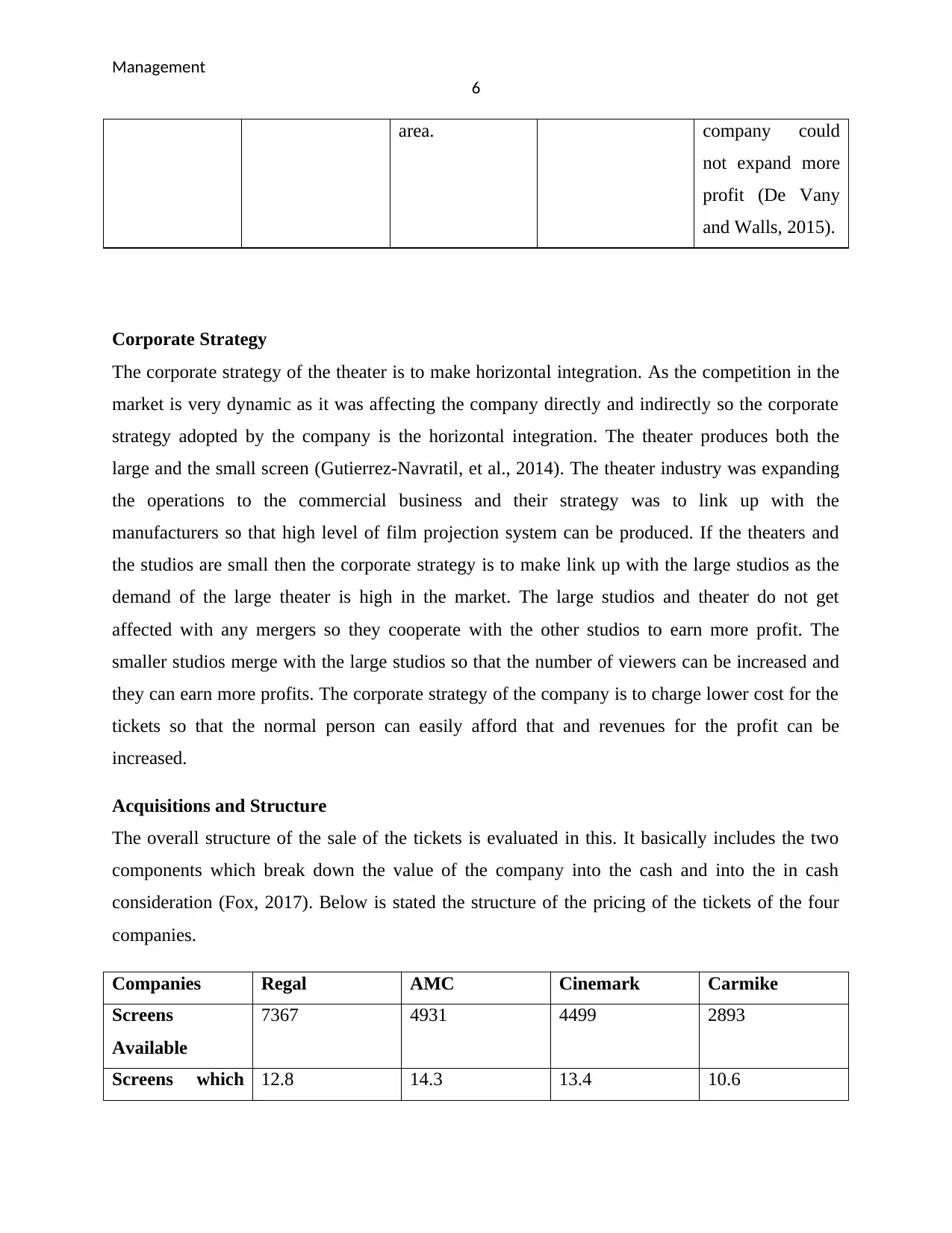
Management
6
area. company could
not expand more
profit (De Vany
and Walls, 2015).
Corporate Strategy
The corporate strategy of the theater is to make horizontal integration. As the competition in the
market is very dynamic as it was affecting the company directly and indirectly so the corporate
strategy adopted by the company is the horizontal integration. The theater produces both the
large and the small screen (Gutierrez-Navratil, et al., 2014). The theater industry was expanding
the operations to the commercial business and their strategy was to link up with the
manufacturers so that high level of film projection system can be produced. If the theaters and
the studios are small then the corporate strategy is to make link up with the large studios as the
demand of the large theater is high in the market. The large studios and theater do not get
affected with any mergers so they cooperate with the other studios to earn more profit. The
smaller studios merge with the large studios so that the number of viewers can be increased and
they can earn more profits. The corporate strategy of the company is to charge lower cost for the
tickets so that the normal person can easily afford that and revenues for the profit can be
increased.
Acquisitions and Structure
The overall structure of the sale of the tickets is evaluated in this. It basically includes the two
components which break down the value of the company into the cash and into the in cash
consideration (Fox, 2017). Below is stated the structure of the pricing of the tickets of the four
companies.
Companies Regal AMC Cinemark Carmike
Screens
Available
7367 4931 4499 2893
Screens which 12.8 14.3 13.4 10.6
6
area. company could
not expand more
profit (De Vany
and Walls, 2015).
Corporate Strategy
The corporate strategy of the theater is to make horizontal integration. As the competition in the
market is very dynamic as it was affecting the company directly and indirectly so the corporate
strategy adopted by the company is the horizontal integration. The theater produces both the
large and the small screen (Gutierrez-Navratil, et al., 2014). The theater industry was expanding
the operations to the commercial business and their strategy was to link up with the
manufacturers so that high level of film projection system can be produced. If the theaters and
the studios are small then the corporate strategy is to make link up with the large studios as the
demand of the large theater is high in the market. The large studios and theater do not get
affected with any mergers so they cooperate with the other studios to earn more profit. The
smaller studios merge with the large studios so that the number of viewers can be increased and
they can earn more profits. The corporate strategy of the company is to charge lower cost for the
tickets so that the normal person can easily afford that and revenues for the profit can be
increased.
Acquisitions and Structure
The overall structure of the sale of the tickets is evaluated in this. It basically includes the two
components which break down the value of the company into the cash and into the in cash
consideration (Fox, 2017). Below is stated the structure of the pricing of the tickets of the four
companies.
Companies Regal AMC Cinemark Carmike
Screens
Available
7367 4931 4499 2893
Screens which 12.8 14.3 13.4 10.6
Paraphrase This Document
Need a fresh take? Get an instant paraphrase of this document with our AI Paraphraser
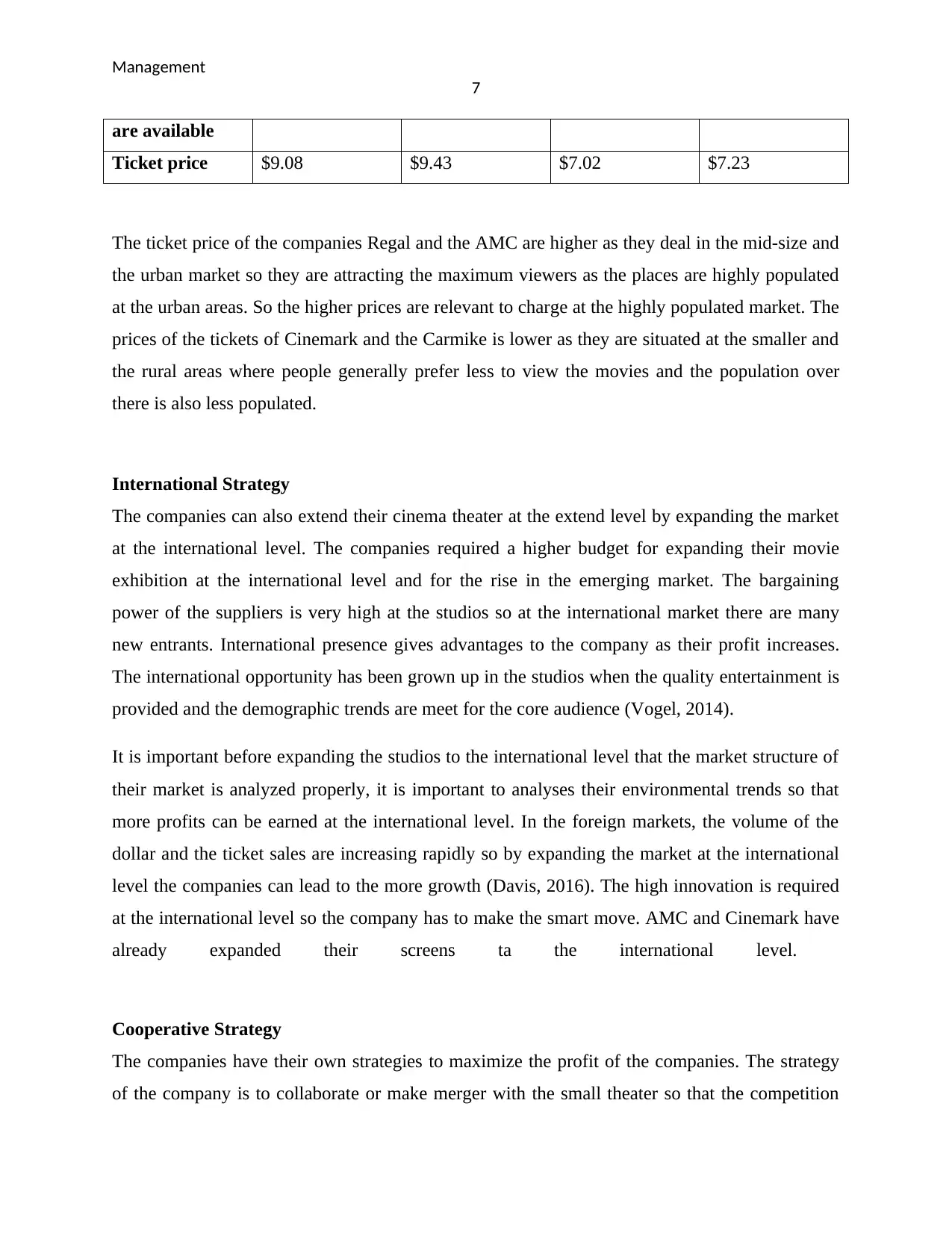
Management
7
are available
Ticket price $9.08 $9.43 $7.02 $7.23
The ticket price of the companies Regal and the AMC are higher as they deal in the mid-size and
the urban market so they are attracting the maximum viewers as the places are highly populated
at the urban areas. So the higher prices are relevant to charge at the highly populated market. The
prices of the tickets of Cinemark and the Carmike is lower as they are situated at the smaller and
the rural areas where people generally prefer less to view the movies and the population over
there is also less populated.
International Strategy
The companies can also extend their cinema theater at the extend level by expanding the market
at the international level. The companies required a higher budget for expanding their movie
exhibition at the international level and for the rise in the emerging market. The bargaining
power of the suppliers is very high at the studios so at the international market there are many
new entrants. International presence gives advantages to the company as their profit increases.
The international opportunity has been grown up in the studios when the quality entertainment is
provided and the demographic trends are meet for the core audience (Vogel, 2014).
It is important before expanding the studios to the international level that the market structure of
their market is analyzed properly, it is important to analyses their environmental trends so that
more profits can be earned at the international level. In the foreign markets, the volume of the
dollar and the ticket sales are increasing rapidly so by expanding the market at the international
level the companies can lead to the more growth (Davis, 2016). The high innovation is required
at the international level so the company has to make the smart move. AMC and Cinemark have
already expanded their screens ta the international level.
Cooperative Strategy
The companies have their own strategies to maximize the profit of the companies. The strategy
of the company is to collaborate or make merger with the small theater so that the competition
7
are available
Ticket price $9.08 $9.43 $7.02 $7.23
The ticket price of the companies Regal and the AMC are higher as they deal in the mid-size and
the urban market so they are attracting the maximum viewers as the places are highly populated
at the urban areas. So the higher prices are relevant to charge at the highly populated market. The
prices of the tickets of Cinemark and the Carmike is lower as they are situated at the smaller and
the rural areas where people generally prefer less to view the movies and the population over
there is also less populated.
International Strategy
The companies can also extend their cinema theater at the extend level by expanding the market
at the international level. The companies required a higher budget for expanding their movie
exhibition at the international level and for the rise in the emerging market. The bargaining
power of the suppliers is very high at the studios so at the international market there are many
new entrants. International presence gives advantages to the company as their profit increases.
The international opportunity has been grown up in the studios when the quality entertainment is
provided and the demographic trends are meet for the core audience (Vogel, 2014).
It is important before expanding the studios to the international level that the market structure of
their market is analyzed properly, it is important to analyses their environmental trends so that
more profits can be earned at the international level. In the foreign markets, the volume of the
dollar and the ticket sales are increasing rapidly so by expanding the market at the international
level the companies can lead to the more growth (Davis, 2016). The high innovation is required
at the international level so the company has to make the smart move. AMC and Cinemark have
already expanded their screens ta the international level.
Cooperative Strategy
The companies have their own strategies to maximize the profit of the companies. The strategy
of the company is to collaborate or make merger with the small theater so that the competition
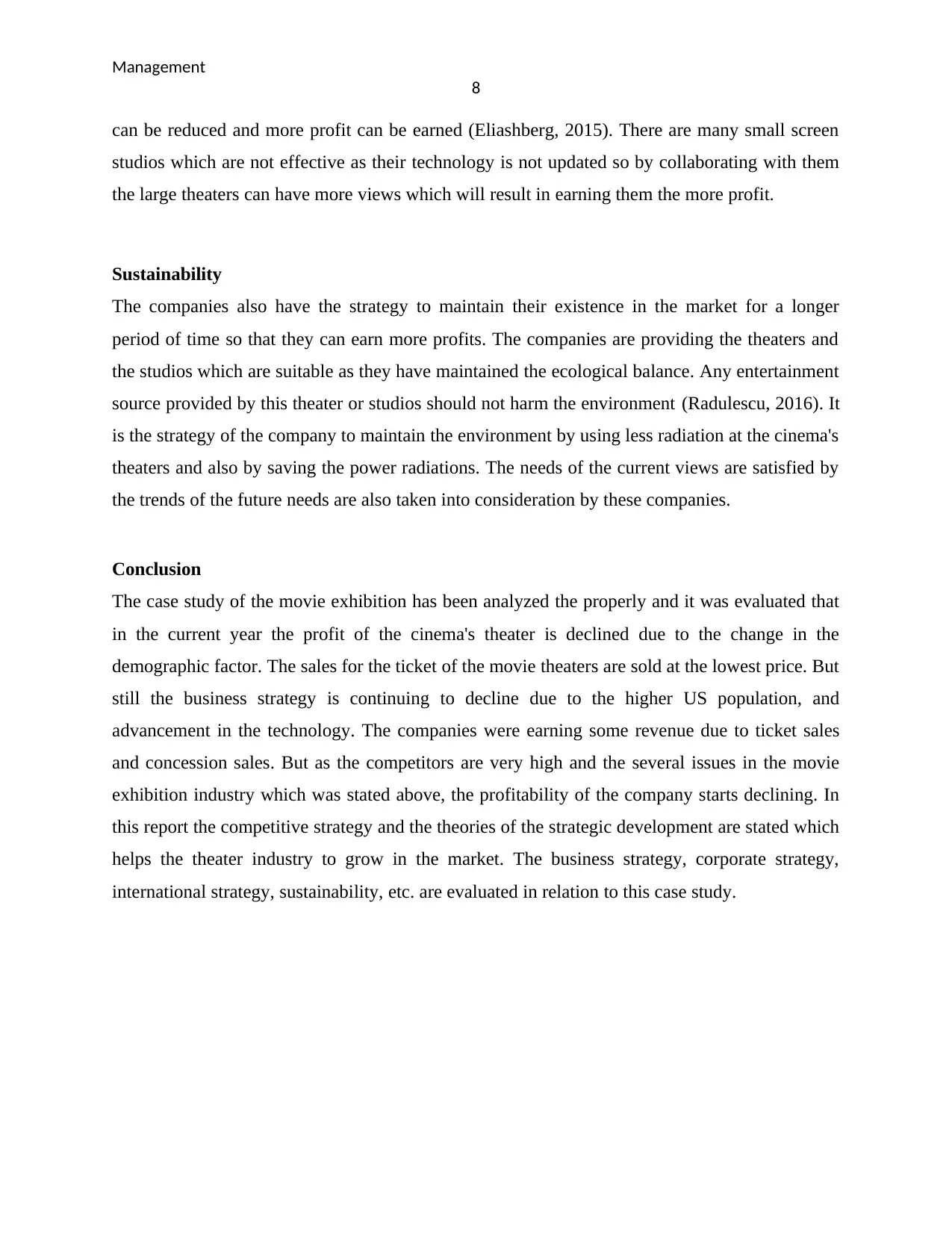
Management
8
can be reduced and more profit can be earned (Eliashberg, 2015). There are many small screen
studios which are not effective as their technology is not updated so by collaborating with them
the large theaters can have more views which will result in earning them the more profit.
Sustainability
The companies also have the strategy to maintain their existence in the market for a longer
period of time so that they can earn more profits. The companies are providing the theaters and
the studios which are suitable as they have maintained the ecological balance. Any entertainment
source provided by this theater or studios should not harm the environment (Radulescu, 2016). It
is the strategy of the company to maintain the environment by using less radiation at the cinema's
theaters and also by saving the power radiations. The needs of the current views are satisfied by
the trends of the future needs are also taken into consideration by these companies.
Conclusion
The case study of the movie exhibition has been analyzed the properly and it was evaluated that
in the current year the profit of the cinema's theater is declined due to the change in the
demographic factor. The sales for the ticket of the movie theaters are sold at the lowest price. But
still the business strategy is continuing to decline due to the higher US population, and
advancement in the technology. The companies were earning some revenue due to ticket sales
and concession sales. But as the competitors are very high and the several issues in the movie
exhibition industry which was stated above, the profitability of the company starts declining. In
this report the competitive strategy and the theories of the strategic development are stated which
helps the theater industry to grow in the market. The business strategy, corporate strategy,
international strategy, sustainability, etc. are evaluated in relation to this case study.
8
can be reduced and more profit can be earned (Eliashberg, 2015). There are many small screen
studios which are not effective as their technology is not updated so by collaborating with them
the large theaters can have more views which will result in earning them the more profit.
Sustainability
The companies also have the strategy to maintain their existence in the market for a longer
period of time so that they can earn more profits. The companies are providing the theaters and
the studios which are suitable as they have maintained the ecological balance. Any entertainment
source provided by this theater or studios should not harm the environment (Radulescu, 2016). It
is the strategy of the company to maintain the environment by using less radiation at the cinema's
theaters and also by saving the power radiations. The needs of the current views are satisfied by
the trends of the future needs are also taken into consideration by these companies.
Conclusion
The case study of the movie exhibition has been analyzed the properly and it was evaluated that
in the current year the profit of the cinema's theater is declined due to the change in the
demographic factor. The sales for the ticket of the movie theaters are sold at the lowest price. But
still the business strategy is continuing to decline due to the higher US population, and
advancement in the technology. The companies were earning some revenue due to ticket sales
and concession sales. But as the competitors are very high and the several issues in the movie
exhibition industry which was stated above, the profitability of the company starts declining. In
this report the competitive strategy and the theories of the strategic development are stated which
helps the theater industry to grow in the market. The business strategy, corporate strategy,
international strategy, sustainability, etc. are evaluated in relation to this case study.
⊘ This is a preview!⊘
Do you want full access?
Subscribe today to unlock all pages.

Trusted by 1+ million students worldwide
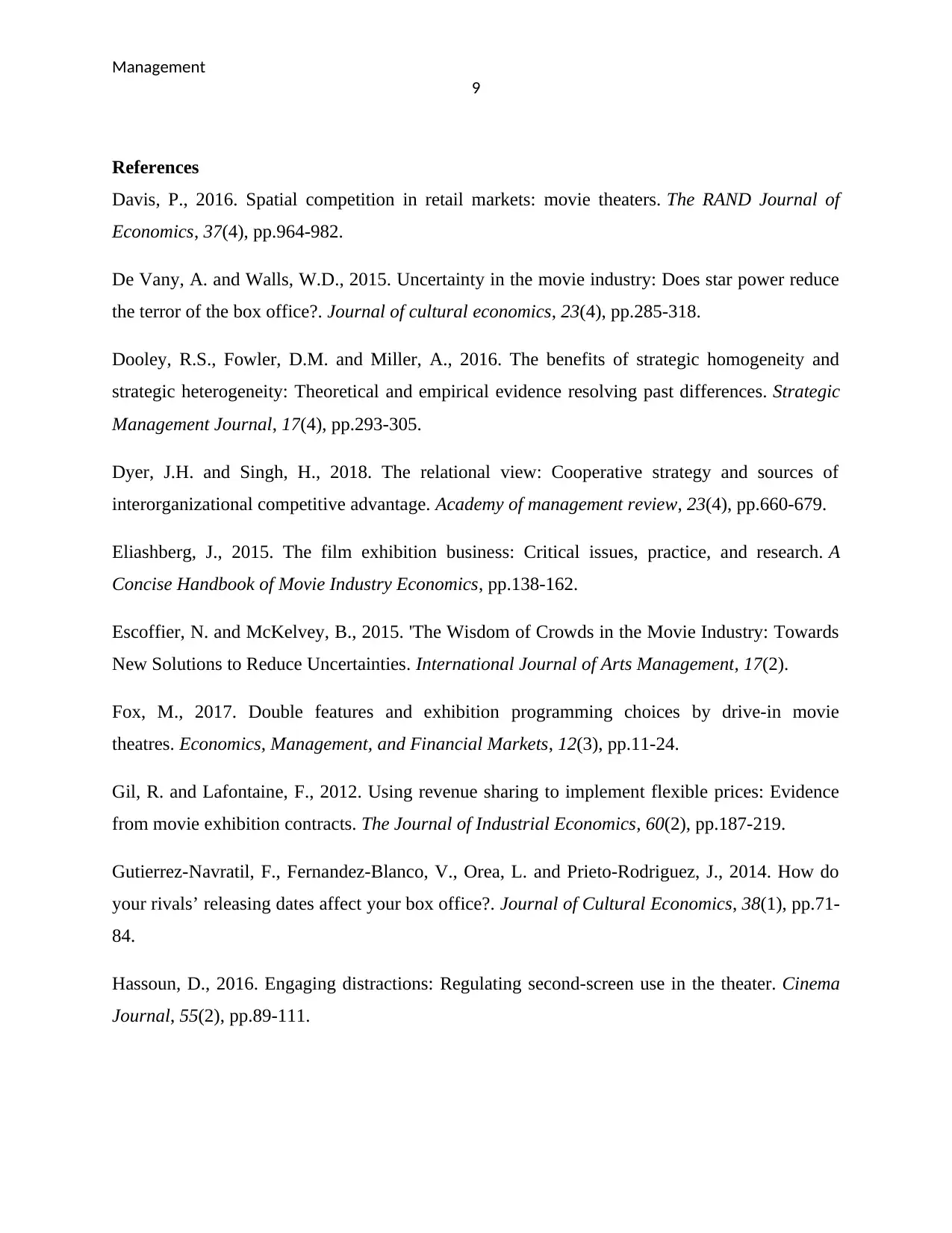
Management
9
References
Davis, P., 2016. Spatial competition in retail markets: movie theaters. The RAND Journal of
Economics, 37(4), pp.964-982.
De Vany, A. and Walls, W.D., 2015. Uncertainty in the movie industry: Does star power reduce
the terror of the box office?. Journal of cultural economics, 23(4), pp.285-318.
Dooley, R.S., Fowler, D.M. and Miller, A., 2016. The benefits of strategic homogeneity and
strategic heterogeneity: Theoretical and empirical evidence resolving past differences. Strategic
Management Journal, 17(4), pp.293-305.
Dyer, J.H. and Singh, H., 2018. The relational view: Cooperative strategy and sources of
interorganizational competitive advantage. Academy of management review, 23(4), pp.660-679.
Eliashberg, J., 2015. The film exhibition business: Critical issues, practice, and research. A
Concise Handbook of Movie Industry Economics, pp.138-162.
Escoffier, N. and McKelvey, B., 2015. 'The Wisdom of Crowds in the Movie Industry: Towards
New Solutions to Reduce Uncertainties. International Journal of Arts Management, 17(2).
Fox, M., 2017. Double features and exhibition programming choices by drive-in movie
theatres. Economics, Management, and Financial Markets, 12(3), pp.11-24.
Gil, R. and Lafontaine, F., 2012. Using revenue sharing to implement flexible prices: Evidence
from movie exhibition contracts. The Journal of Industrial Economics, 60(2), pp.187-219.
Gutierrez-Navratil, F., Fernandez-Blanco, V., Orea, L. and Prieto-Rodriguez, J., 2014. How do
your rivals’ releasing dates affect your box office?. Journal of Cultural Economics, 38(1), pp.71-
84.
Hassoun, D., 2016. Engaging distractions: Regulating second-screen use in the theater. Cinema
Journal, 55(2), pp.89-111.
9
References
Davis, P., 2016. Spatial competition in retail markets: movie theaters. The RAND Journal of
Economics, 37(4), pp.964-982.
De Vany, A. and Walls, W.D., 2015. Uncertainty in the movie industry: Does star power reduce
the terror of the box office?. Journal of cultural economics, 23(4), pp.285-318.
Dooley, R.S., Fowler, D.M. and Miller, A., 2016. The benefits of strategic homogeneity and
strategic heterogeneity: Theoretical and empirical evidence resolving past differences. Strategic
Management Journal, 17(4), pp.293-305.
Dyer, J.H. and Singh, H., 2018. The relational view: Cooperative strategy and sources of
interorganizational competitive advantage. Academy of management review, 23(4), pp.660-679.
Eliashberg, J., 2015. The film exhibition business: Critical issues, practice, and research. A
Concise Handbook of Movie Industry Economics, pp.138-162.
Escoffier, N. and McKelvey, B., 2015. 'The Wisdom of Crowds in the Movie Industry: Towards
New Solutions to Reduce Uncertainties. International Journal of Arts Management, 17(2).
Fox, M., 2017. Double features and exhibition programming choices by drive-in movie
theatres. Economics, Management, and Financial Markets, 12(3), pp.11-24.
Gil, R. and Lafontaine, F., 2012. Using revenue sharing to implement flexible prices: Evidence
from movie exhibition contracts. The Journal of Industrial Economics, 60(2), pp.187-219.
Gutierrez-Navratil, F., Fernandez-Blanco, V., Orea, L. and Prieto-Rodriguez, J., 2014. How do
your rivals’ releasing dates affect your box office?. Journal of Cultural Economics, 38(1), pp.71-
84.
Hassoun, D., 2016. Engaging distractions: Regulating second-screen use in the theater. Cinema
Journal, 55(2), pp.89-111.
Paraphrase This Document
Need a fresh take? Get an instant paraphrase of this document with our AI Paraphraser
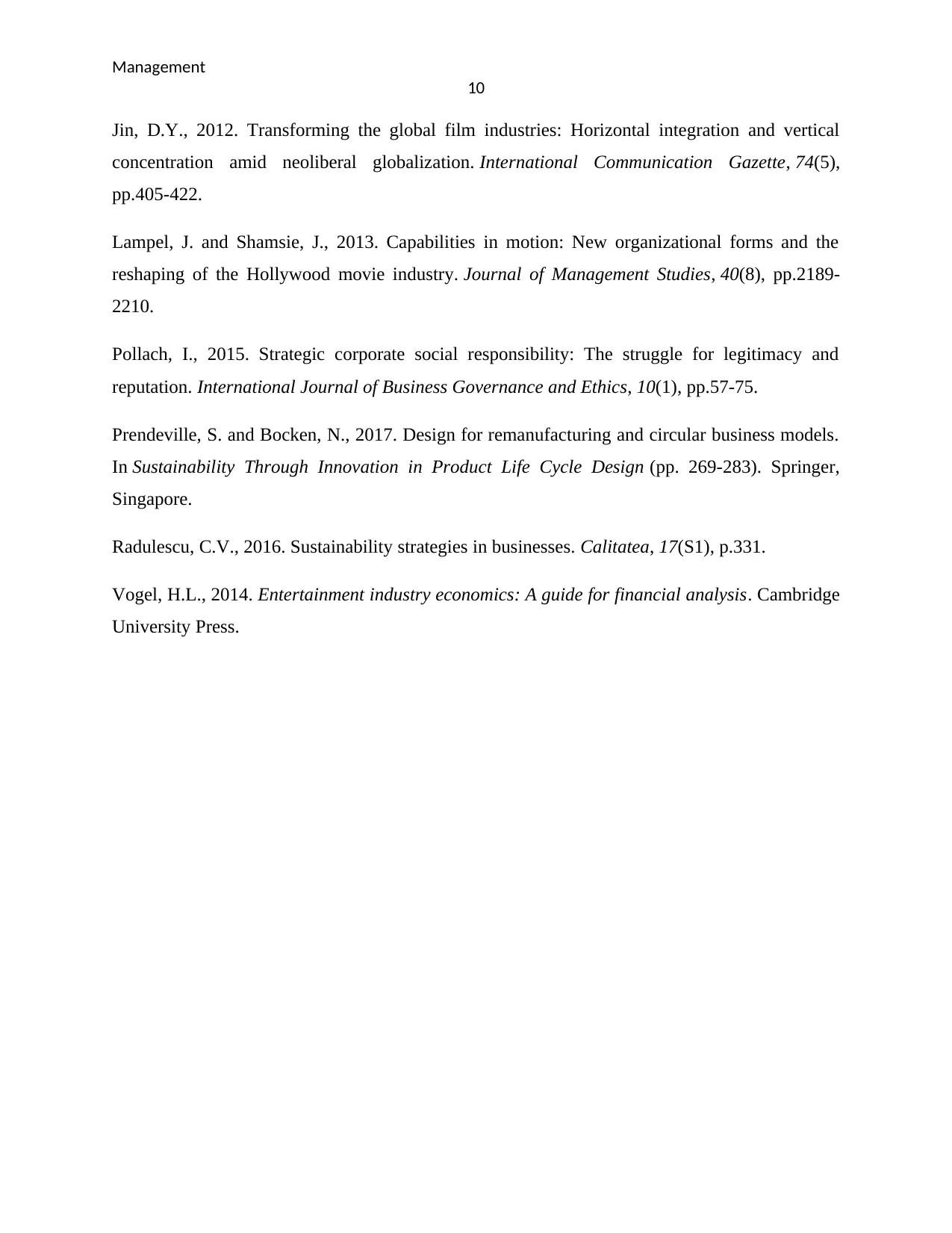
Management
10
Jin, D.Y., 2012. Transforming the global film industries: Horizontal integration and vertical
concentration amid neoliberal globalization. International Communication Gazette, 74(5),
pp.405-422.
Lampel, J. and Shamsie, J., 2013. Capabilities in motion: New organizational forms and the
reshaping of the Hollywood movie industry. Journal of Management Studies, 40(8), pp.2189-
2210.
Pollach, I., 2015. Strategic corporate social responsibility: The struggle for legitimacy and
reputation. International Journal of Business Governance and Ethics, 10(1), pp.57-75.
Prendeville, S. and Bocken, N., 2017. Design for remanufacturing and circular business models.
In Sustainability Through Innovation in Product Life Cycle Design (pp. 269-283). Springer,
Singapore.
Radulescu, C.V., 2016. Sustainability strategies in businesses. Calitatea, 17(S1), p.331.
Vogel, H.L., 2014. Entertainment industry economics: A guide for financial analysis. Cambridge
University Press.
10
Jin, D.Y., 2012. Transforming the global film industries: Horizontal integration and vertical
concentration amid neoliberal globalization. International Communication Gazette, 74(5),
pp.405-422.
Lampel, J. and Shamsie, J., 2013. Capabilities in motion: New organizational forms and the
reshaping of the Hollywood movie industry. Journal of Management Studies, 40(8), pp.2189-
2210.
Pollach, I., 2015. Strategic corporate social responsibility: The struggle for legitimacy and
reputation. International Journal of Business Governance and Ethics, 10(1), pp.57-75.
Prendeville, S. and Bocken, N., 2017. Design for remanufacturing and circular business models.
In Sustainability Through Innovation in Product Life Cycle Design (pp. 269-283). Springer,
Singapore.
Radulescu, C.V., 2016. Sustainability strategies in businesses. Calitatea, 17(S1), p.331.
Vogel, H.L., 2014. Entertainment industry economics: A guide for financial analysis. Cambridge
University Press.
1 out of 11
Related Documents
Your All-in-One AI-Powered Toolkit for Academic Success.
+13062052269
info@desklib.com
Available 24*7 on WhatsApp / Email
![[object Object]](/_next/static/media/star-bottom.7253800d.svg)
Unlock your academic potential
Copyright © 2020–2025 A2Z Services. All Rights Reserved. Developed and managed by ZUCOL.



